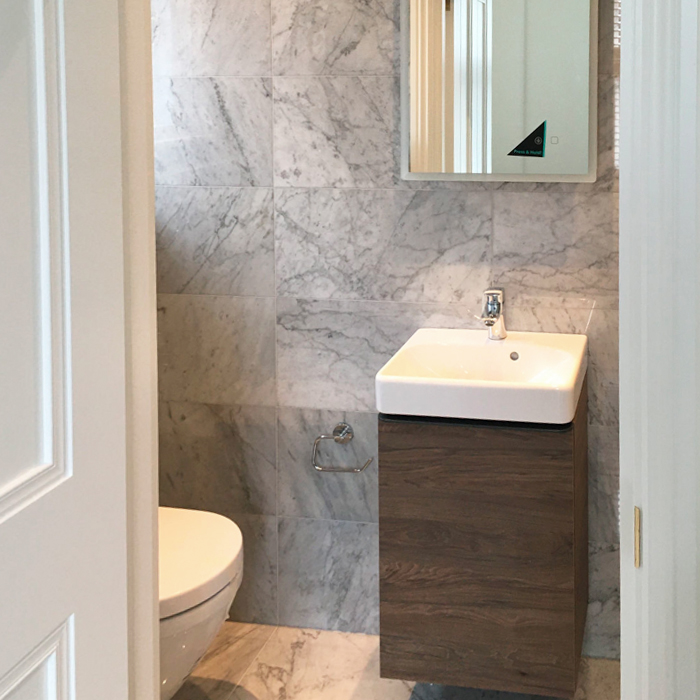When choosing new flooring, people can often confuse marble and travertine, with the latter sometimes even considered by many to be a variation of the former - but this is not the case! In fact, both stones are unique, and each has a specific look and feel to it. Using marble will give you a modern, streamlined look, whereas the pits and pores of travertine will create more of a raw, earthy feel.
However, appearance isn’t the only way these stones vary, there are also other important factors to consider surrounding cost and durability. Within this article, we’ve set out the key similarities and differences between marble and travertine tiles, as well as the benefits and drawbacks of each.
![]()
Travertine vs marble flooring: what are the similarities?
With both being a veined, natural stone, it is perhaps unsurprising that marble and travertine are often confused, especially as they share many of the same physical properties.
Both are a type of natural stone
Both hard and durable natural stone tiles, marble and travertine are a popular choice for home interior and architectural projects. Although durable, marble and travertine are softer than other popular stones, such as granite and quartz, and have a more porous surface, meaning sealing is an absolute must to avoid staining.
Available in an array of colours
Both marble and travertine come in a range of shades, and tend to feature softer, natural hues. Their subtle tones mean they’re perfect for making any space feel lighter and brighter, while polishing marble or travertine will create stunning reflective tiled surfaces for a more opulent, high end look.
Each requires careful maintenance
Finally, both stones require careful maintenance to ensure longevity and keep their beautiful appearance in top condition. Applying harsh chemicals, abrasive tools or acid-based solutions will damage the natural surface, so be sure to use appropriate products or simple soap and water when cleaning them. When cared for adequately, both marble and travertine are practical surface solutions that can last a lifetime, enduring decades of wear and tear!
Marble vs travertine tiles: what are the differences?
Although they share similarities, marble and travertine do bare some key differences, from fine appearance and texture variabilities to their price tag.
How does their texture and appearance differ?
Perhaps the most prominent difference between marble and travertine is that marble is smoother with distinct scattered veining – a key characteristic of the natural material formation. Whereas, travertine has a recognisable roughness, with more subtle, ‘linear’ veining that is formed by layers of aged sedimentary material over time.
While both relatively soft-shaded stones, the colour palettes of marble and travertine do differ slightly. Marble tends to be slightly lighter (think whites and greys), whereas travertine is known to feature warmer creams and beige tones.
Is marble or travertine more expensive?
Importantly, marble and travertine do also differ in price and is an important factor to consider when weighing up your project budget. Marble tends to be the more costly stone, due to its rarity and luxurious reputation, while the additional finish process of polishing or honing the marble tile surface can also add to the higher price tag.

Our Bianco Carrara Marble tiles are available in honed and polished finishes
Should you choose marble or travertine tiles?
If you’re comparing travertine vs marble, it helps to have a clear understanding of the pros and cons of each. We’ve outlined the reasons you might want to consider marble vs travertine – and vice versa.
Why choose marble tiles?
Elegant: With its reflective properties, marble has an unparalleled elegance, and is a popular choice for those seeking versatility, and visual impact.
Durability: Perhaps marble’s best feature is its durability. When cared for properly, marble can last a lifetime, making it the perfect option for flooring, splashbacks, and even worktops.
Longevity: Natural marble is ideal for bathroom and kitchen use, withstanding heat and accidental splashes, when sealed effectively.
Can mask wear and tear: Additionally, the veined nature of marble means that if it does suffer natural wear and tear, the imperfections are better disguised.
Why choose travertine tiles?
Distinctive appearance: Travertine is formed by layers of sedimentary rock and material over the years, and this is what gives it its distinctive, layered and pitted appearance.
Affordable: Travertine does tend to be the more affordable option of the two, so if you’re working with a smaller budget, it may be the best option for you.
Hopefully, you now have a strong understanding of the similarities and differences between marble and travertine tiles, and an idea of which to use for your next project depending on your requirements. Although travertine and marble-effect tiles are comparable in many ways, they each hold their own unique characteristics, and understanding this is key to deciding which one is right for you.
If you’re ready to get your project planning underway, why not order up to three free tile samples today, or discover even more tile inspiration from our experts over on our blog.

